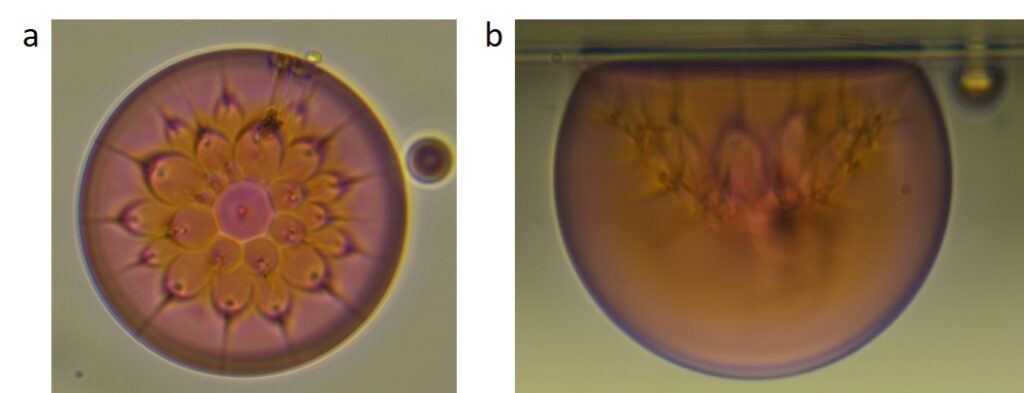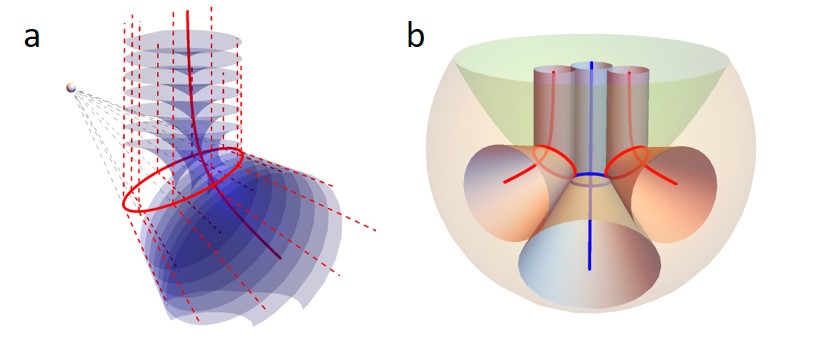In collaboration with a researcher from the University of Pennsylvania and a Ukrainian scientist, a professor from the Laboratoire de Physique des Solides (Paris-Saclay) has shed light on three-dimensional architecture built spontaneously by defects in a cholesteric drop placed on a flat surface. The conditions under which the cholesteric layers are anchored on the flat surface and at the interface of the drop with the surrounding medium give rise to focal domains based on ellipses distributed on a paraboloid within the drop. These focal domains are organized in a remarkable 3D geometrical architecture of which a complete model is proposed.
A cholesteric liquid crystal, helical arrangement of liquid crystal, behaves like a layered system like smectics where molecules arrange themselves in liquid layers: it is then the cholesteric periodicity (or pitch) that plays the role of layer when the pitch is small. A cholesteric drop immersed in glycerol has a concentric layered structure. When it lands by gravity on a glass surface, a flower-like architecture appears as seen by optical microscopy from above (Figure 1a). The cholesteric pitch is 0.33 mm for a drop diameter of 130 mm. A profile view (Fig. 1b) provides a better visualization of the 3D architecture.

Figure 1. Cholesteric drop with a diameter of 130 mm diameter observed under light microscopy either from above (a) or from the side (b).
The conditions for anchoring molecules to interfaces are such that the cholesteric layers prefer to be parallel to both the planar and spherical interfaces. This geometric condition can be satisfied by introducing focal domains, an original arrangement of layers associated with a pair of conics. Each focal domain is defined by an ellipse+ hyperbola pair, solid red lines in Fig. 2a. The layers in the focal domain are shown in blue in Fig. 2a, following surfaces known as Dupin cyclides. The floral appearance is due to the association of several of these focal domains whose ellipses are distributed over a paraboloid (in green) that separates the drop into two regions (Fig. 2b). Inside the paraboloid, in contact with the glass surface, each focal domain is bounded by a cylinder, enabling perfect contact with flat layers parallel to the glass surface and ensuring a perfect connection between the focal domains. Outside the paraboloid, each focal domain is bounded by a cone centered on the focus of the paraboloid, ensuring perfect contact with spherical layers centered on this focus and distributed between the focal domains. The only places where the director is not defined are located on the ellipses and hyperbolas that appear in black in the photos Fig.1a and 1b.

Figure 2. Each focal domain (a) is supported by an ellipse and a hyperbola (solid red lines). The floral appearance is linked to the association of several focal domains whose ellipses are distributed on a paraboloid (b).
Although this architecture has already been observed in liquid crystals, it is the first time that it has been visualized and interpreted in 3D. Moreover, unlike in the smectic case, the layered organization is not sufficient to fully describe the structure in the case of a cholesteric liquid crystal. Indeed, the distribution of the director which defines the orientation of the molecules within the layers remains to be specified. Given the topology of Dupin cyclides, new defects in the orientation of the director must be introduced, further complicating the analysis of the structure. This work combining experimental measurements and theoretical description has been recently published in the journal Proceedings of the National Academy of Sciences.
Reference
Geometry of Focal Conics in Sessile Cholesteric Droplets
Randall D. Kamien, Yuriy Nastishin and Brigitte Pansu
PNAS, 2023, 120, 46, e2311957120
DOI: 10.1073/pnas.2311957120
Contact
Brigitte Pansu
